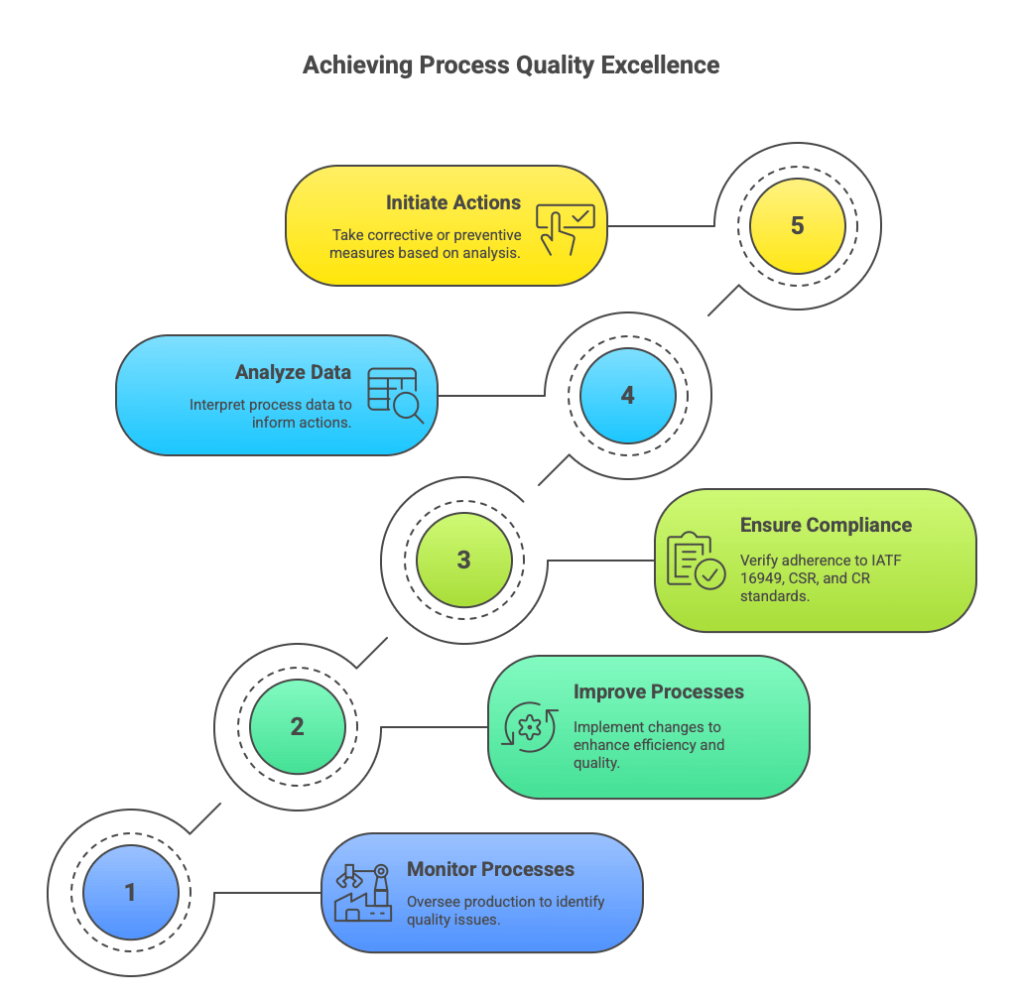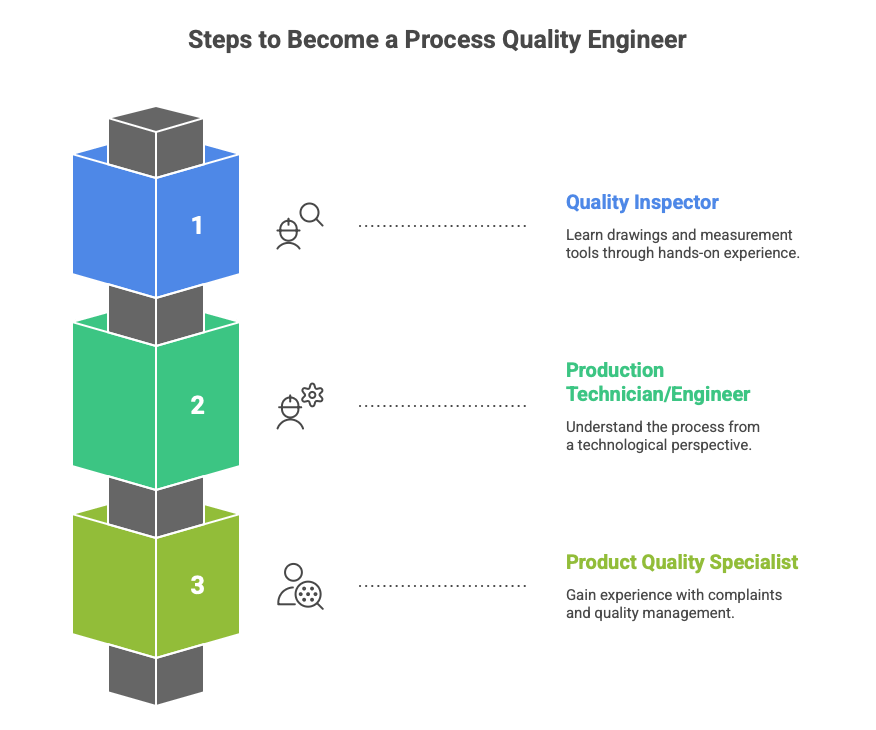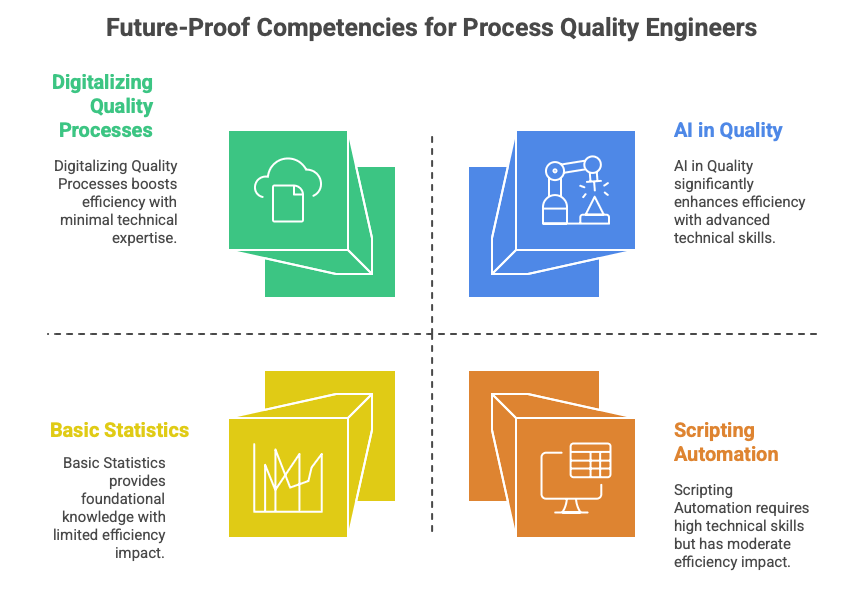If you work in a quality department or want to enter the automotive industry, you’ve probably already heard the term Process Quality Engineer. It sounds serious, but what does it actually mean? Is it someone who supervises production, analyzes customer complaints, conducts audits—or all of the above?
This article will help you put it all together.
The role of a Process Quality Engineer is more than just “inspection” or “compliance with requirements.” It’s a profession at the intersection of three worlds: production, the customer, and the quality management system. And that’s exactly why it’s so important—because everything starts at the process level: product quality and, ultimately, customer satisfaction.
Process vs. Product – Where Quality Really Begins
Most quality problems don’t come from design errors—they come from how that design is executed on the shop floor. And this is where the Process Quality Engineer steps in—someone whose job is to co-create and oversee processes in a way that prevents problems rather than just “putting out fires” at the end of the line.
Quality can’t be inspected in at the end—it has to be built into the process.
Sounds like a cliché? Maybe. But if you work in automotive, you know that the gap between theory and practice can be as wide as a production hall and a missed delivery from a sub-supplier.
Customers Don’t Just Want “Compliant Products” – They Want Stable Processes
The reality is that most customers (read: OEMs and Tier 1 suppliers) no longer look only at whether you delivered a good part. They want to know:
Do you have a stable, validated process?
What process audits are performed (CQI, VDA 6.3, LPA)?
Do you apply core tools and know how to interpret SPC results?
Do you draw lessons from issues before they turn into complaints?
That’s why more and more frequently, in RFQs and during audits, the questions aren’t about the product itself, but about… the process that produces it—and more specifically, about who’s in charge of that process.
Being a Process Quality Engineer is not a fairy tale about working quietly at a desk while sipping coffee. It’s more like constantly balancing between production, the customer, the auditor, and your own conscience.
But if you like a fast-paced environment, aren’t afraid of challenges, and have an open mind for a systems-based approach—this role might just be your natural habitat.
Who Is a Process Quality Engineer?
Imagine the production process as a rock concert. You’ve got the guitarist (the process engineer), the lead singer (the operator), the tour manager (the production manager), and… someone standing just off stage, holding the setlist, knowing exactly where a cable might unplug, and making sure nobody hits a wrong note or misses a chord.

In the automotive industry, this role is played by the Process Quality Engineer (PQE) — the person typically responsible for:
Monitoring and improving production processes from a quality perspective,
Ensuring process compliance with IATF 16949, customer-specific requirements (CSR), and individual customer requirements (CR),
Analyzing process data and initiating corrective or preventive actions.
As you can see, the foundation of a PQE’s work isn’t just about keeping parameters in check — it’s about making sure the entire process is repeatable, predictable, and properly centered.
From the company’s point of view, this is the ultimate liaison:
Between production (“Line 3 is down again because the camera isn’t working”),
Quality (“We need to prove to the customer that we have the process under control”),
Process engineering (“Will this change in press settings kill our Cpk?”),
And sometimes… the customer (“Please show evidence that the process complies with PFMEA”).
This position requires not only technical knowledge, but also mental resilience and the ability to communicate with everyone — from operators to auditors (internal or third-party).
That “someone” in the automotive world? That’s the Process Quality Engineer.
| Role | Main Responsibilities | When They Step In |
|---|---|---|
| Process Quality Engineer | Monitors and improves processes, analyzes SPC data, participates or conducts process audits, implements corrective actions in the process | When it’s necessary to prevent a problem or restore process stability |
| Product Quality Engineer | Focuses on final product inspection, handling customer complaints, PPAP submissions, and product compliance with customer requirements | When the product does not meet requirements or its compliance needs to be proven, managing customer audits |
| Process Engineer | Designs, implements, and optimizes the manufacturing process from a technical and efficiency standpoint | When it’s necessary to change or develop a process |
In practice, the boundaries have been (and still are) fluid. In smaller plants, one person may perform both roles — combining process quality with product quality.
As you can see, in manufacturing it’s not only about what you deliver, but also how it is made. A single nonconforming part — if detected and stopped by the process — usually has no negative impact on the cooperation. A process that cannot be controlled, however, can quickly lead to escalation.
Process Quality Engineer – Responsibilities and a Day in the Life
If you think a Process Quality Engineer’s day is all about sitting quietly in an office and filling out Excel sheets… it’s not.
At least — not for the whole day.
It’s more like working in a loop: office – shop floor – meeting – shop floor – meeting – shop floor – reports. And repeat.
Morning – Process Status Check
You start with coffee — an unofficial requirement not listed in the control plan, but definitely embedded in the DNA of most quality engineers. 🙂 Then you open the production reports:
How did the SPC indicators look during the last shift?
Were there any line stoppages?
Did anyone report issues with special characteristics?
This part of the day usually ends with a calibration meeting with your team and your manager.
Late Morning – Shop Floor and Current Issues
You head out to the shop floor, because that’s where the process really happens.
You check the stations with key characteristics.
You verify that the control plan requirements are being followed.
You talk to operators — they are often the first to notice deviations before they show up in the statistics.
If a problem arises — for example, a drop in Cpk below customer requirements — you need to quickly organize a root cause analysis (5Why, QRQC) and implement corrective actions before the issue gains traction.
Afternoon – Projects, Audits, Preventive Actions
This is often when the more “complex” tasks come into play:
Preparing for a customer audit — compiling evidence, updating process documentation, reviewing PFMEA (including potential Reverse FMEA).
Participating in new launches — approving the line from a quality standpoint (Run@Rate, production trials, verification of error-proofing and mistake-proofing).
Reviewing actions from 8D Reports or A3s that resulted from previous issues.
Checklist – Process QE Responsibilities at a Glance
Process monitoring – SPC, reports, corrective actions.
Process audits – internal, LPA, and customer-required (CQI, VDA 6.3).
Maintaining quality documentation – control plans, PFMEA, work instructions, and distributing Quality Alerts resulting from customer complaints.
Collaboration with production – solving current issues, training operators through focused “lesson learned” sessions.
Problem analysis – 5Why, Ishikawa, QRQC, A3.
Support during new launches – process approval and validation.
Customer communication – reporting results, explaining deviations.
Being a Process Quality Engineer means you are the first line of defense against chaos. Your success is measured by the fact that the customer sees a stable process, production feels supported, and you… have the satisfaction of knowing that a problem was solved before it ever landed on the Quality Manager’s desk.
Process Quality Engineer – Key Tools and Methods
“Without quality tools, you’re like a mechanic without wrenches.” There’s a lot of truth in that. But just as important is knowing when, how, and why to use them—because nothing demotivates production more than paperwork that doesn’t solve the problem.
Core Tools – the foundation of daily work
1. APQP – Advanced Product Quality Planning
Quality planning during design and launch. For a Process QE, the crucial stage is Phase: Feedback, Assessment & Corrective Action, where you verify whether the process actually performs as planned in the FMEA and control plans. If APQP is done “for the customer” rather than for the process, the problems will come back—just later and more expensively.
2. PPAP – Production Part Approval Process
Formal approval of the component and the process by the customer. The Process QE ensures that:
Control Plans reflect real, serial production,
SPC data are current and trustworthy,
Documentation is consistent with the customer’s CSR.
Most common pitfall? Data from “ideal” pilot runs that don’t match serial reality.
3. FMEA – Failure Mode and Effects Analysis
Your minefield and roadmap in one. The Process QE uses PFMEA to:
Identify critical points in the process,
Build the Control Plan around special characteristics,
Plan effective preventive actions.
A good PFMEA isn’t a checklist—it’s a living document that evolves with process changes.
4. MSA – Measurement System Analysis
If measurements aren’t reliable, all your SPC data belong in the bin. Very often the issue with SPC data isn’t the process—it’s the measurement system. The Process QE makes sure that:
GR&R, bias, and linearity are within acceptable limits,
Measurement systems are periodically verified,
Operators follow clear measurement procedures.
5. SPC – Statistical Process Control
Your day-to-day radar. Often the biggest challenge isn’t the analysis—it’s timely data entry. SPC means:
Reading and acting on control charts,
Responding to out-of-control signals,
Adjusting the process before the product goes nonconforming.
How to Start a Career as a Process Quality Engineer
Not everyone is born a Process Quality Engineer. Most people arrive from other roles—sometimes by chance, sometimes by choice. The good news? You can grow into this position step by step, as long as you consistently build your skills.

Typical Entry Paths into the Process QE Role
Quality Inspector
Start in incoming, in-process, or final inspection.
You learn drawings, special characteristics, and basic measurement tools.
Plus: you get hands-on, real-time exposure to the process.
Production Technician/Engineer
You know the process from the technological side, which makes it easier to understand its impact on quality.
You often already collaborate with Quality when solving problems.
Product Quality Specialist (Product QE)
You have experience with complaints, PPAP, and APQP.
You transition toward proactive, process-focused quality management.
If you’re already in a manufacturing organization, volunteer for quality projects—even if they’re not formally in your job description. It’s a great way to step into the Process QE space. Remember: being proactive pays off far more than being reactive—because it widens your range of opportunities. This principle works brilliantly not only at work, but in life in general.
Which Competencies Are Future-Proof for a Process Quality Engineer?
The automotive industry is at a point where classic quality tools (SPC, FMEA, audits) are a must-have, but companies increasingly look at what you can do beyond the standard. That’s where competencies come in that, over the next 3–5 years, can become your strongest differentiator on the job market.
1. Process Data Analytics
Today, most machines and production systems collect massive amounts of data. The problem? Few engineers can analyze it and draw conclusions faster than a customer can call with a complaint.

Being able to work with tools like Power BI, Tableau, Minitab, or even advanced Excel, is gold.
A solid grasp of basic statistics and data visualization lets you anticipate issues before they show up in the process.
Instead of scanning 50 SPC reports every day, you build a dashboard that automatically highlights processes at risk of breaching control limits.
2. Using AI in Quality
Artificial intelligence isn’t just ChatGPT or image generation. In automotive, AI can:
Analyze images and camera signals in visual inspection,
Predict machine failures based on data trends,
Assist in analyzing complaint texts or 8D reports.
You can train an AI model that automatically rejects nonconforming parts from visual inspection images—faster and more accurately than a human.
Of course, check internal policies and data-governance rules first to confirm what information may be used to train or feed the model.
3. Digitalizing Quality Processes
Paper control plans and binders full of FMEAs are becoming history. Companies are investing in:
Real-time production tracking,
Cloud-updated documents,
Digital checklists and audits with automatic report generation and notifications.
4. Scripting and Reporting Automation
This is a step up. You don’t need to be a full-time developer, but knowing the basics of Python, VBA, or SQL can dramatically speed up your work:
Automatically pull data from systems,
Generate SPC reports,
Run trend analyses without clicking through hundreds of sheets.
In the next few years, the standard Process Quality Engineer will not only react to problems but predict them through data analysis, will skillfully use AI and automation in daily work, and will manage processes in a fully digital environment. These are the skills that will separate a “good” specialist from a great one in this role.
Author: Dariusz Kowalczyk


